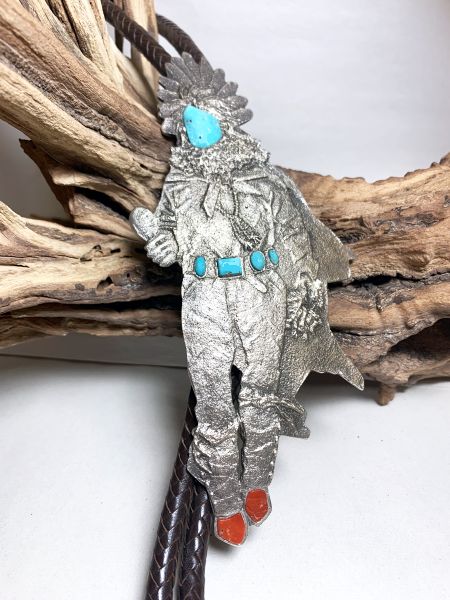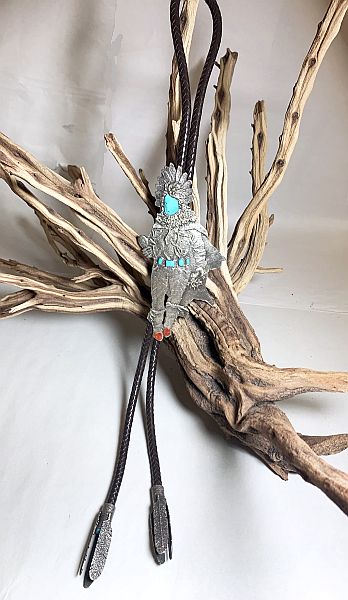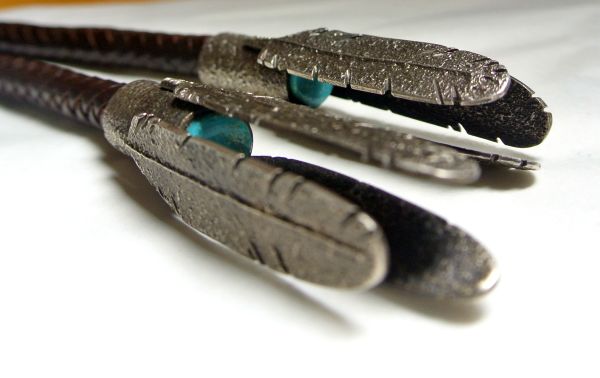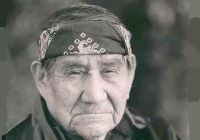Sterling silver tufa cast Yei Bi Chai bolo by award-winning artist/silversmith Orland C. Joe. The 3 1/4” x 6 3/4” Yei Bi Chai has a turquoise face, four turquoise in the concho belt and coral moccasins. The tips on the leather braid cord are made up of three silver feathers with turquoise inside.
Call for shipping
The Yei Bi Chai are human dancers who impersonate the Yei (Navajo Holy People). They participate in the Nightway Ceremony (healing ceremony), not only for physical health but mental, emotional, spiritual and material well-being.
About the artist
ORELAND C. JOE, SR.
Oreland Joe is world-renowned for his work in stone and bronze sculpture. His works can be found in private, corporate, and museum collections in the United States and abroad. Oreland Joe was born in Shiprock, New Mexico on June 3, 1958. He is a native of New Mexico and is of Dine' (Navajo) and Ute descent. Oreland Joe grew up in the four-corners area most of his life, both on the Navajo and Ute reservations. Currently, Kirtland, New Mexico is home to his family and studio.
Oreland Joe knew, by the age of four, he wanted to be an artist. As a young man, he experienced various influences that have formed the man who commands admiration and respect in today's contemporary art world.
The most important influences Oreland Joe had throughout his life include his family - his father, mother, grandfather, and teachers. These individuals provided encouragement, support, and the inspiration to grow his artistic talents. He found his father's work as a silversmith and painter, his mother's musical talent, and his grandfather's participation in traditional songs and dances provided him with cultural inspiration and appreciation for history. These experiences provided Oreland Joe with a rich and viable life which is the catalyst that has spun his ideas, images and creativity into a successful career. Oreland Joe's work in bronze has proven to be just as popular as his works in stone. Oreland primarily works with marble, alabaster, and limestone.
While in France and Italy in 1978 and 1984, Oreland Joe was able to capture, in heart and mind European art and culture. Seeing and feeling the impressive artistic works of the Greek, Roman, Renaissance and Baroque periods provoked another dimension in Oreland's artistic life. His favorite sculptor is Antonio Canova, an 18th-century Italian sculptor, whose work studied on a trip to Italy in 1986. Joe works primarily in stone including alabaster, marble, and limestone. In 1986, a trip to Japan introduced a new concept as well as a wider perception/perspective of art in other cultures. The time Oreland Joe spends studying the arts and art history of the European masters (Bernini, Canova, and Michelangelo) are actually his "periods of inspiration." A constant study of the sculpture of Italy, France, Japan, England, and Egypt continues to enhance Oreland Joe's work. Researching and working with ideas and depictions of Native American lifestyles, songs, and dances of the 1800-1920s has always been a favorite as well. Images from this time span continue to give Oreland Joe a sense of home.
Orland Joe is known for his incredible sculptors. However, this Navajo and Ute artist is like most creative people and attracted to new techniques and styles. Like his signature sculptors he uses his carving tools to make the detailed Yei' be' Chi' from tufa stone. The detail work of his meticulous bronze sculptures translates to his new passion of jewelry making.
In 1993, Oreland Joe received the distinct honor of becoming the first Native American artist to be a member of the famed and prestigious organization "Cowboy Artist of America." This honor launched Oreland to new heights in his career. In 1996, he was chosen out of 50 artists by the Ponca City Native American Foundation to produce a twenty-two foot bronze sculpture of "Chief Standing Bear." It is Oreland Joe's crowning achievement to date and his most public artistic statement.
Oreland Joe's love for art has placed him in an elite class of stone and bronze sculptors known throughout the world. In spite of all his accomplishments and ever-growing popularity, Oreland Joe remains humble, sensitive, and grateful. He still finds time to teach others at his studio or workshops. He continues to be "down to earth" as the foundation that sustains him is still derived from his family, good friends, Creator. He serves as a great role model for all young people.
-Excerpted Rose Toehe, Flagstaff, Arizona
Artist Statement:
"I find strength, faith, and dignity through my heritage, yet I also find these same things in other cultures - and I derive inspiration and motivation from them as well. In my humble opinion, I'm just an artist who happens to be Native American. I find myself in a unique place of having the blessing of both worlds. And my goal and desire is to have more Native American artists to be in this place".

















